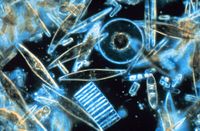
Photo from wikipedia
Abstract We evaluated the response of diatom community relative to environmental changes with the aim of characterizing and comparing, along a linear gradient, three environments across the Cascavel River microbasin… Click to show full abstract
Abstract We evaluated the response of diatom community relative to environmental changes with the aim of characterizing and comparing, along a linear gradient, three environments across the Cascavel River microbasin with distinct land-uses. In June 2016, 10 substrates were collected for periphyton extraction in locations with different land-uses (conservation, urban, and agriculture respectively). One-hundred and nine infrageneric taxa and 30 genera were found. Eunotia and Gomphonema presented elevated and representative taxa richness at all stations, with totals of 14 and 11 respectively. Pinnularia and Navicula (12 and 8 taxa respectively) were significant indicators at the more upstream points; while Encyonema, Achnanthidium and Navicula (5, 5, and 6 taxa respectively) occurred primarily downstream. The sampling stations were quite distinct in their densities, species richness, and physical, chemical, and biological characteristics. The tests showed a significant difference among the stations based on the species abundance matrix. Upstream points, within the conservation area, revealed high Eunotia density, high nitrate concentrations and low pH. The urbanized area was characterized by greater exposure to light associated with elevated electrical conductivity and high ammoniacal nitrogen concentration, favoring the cosmopolitan species development such as Gomphonema lagenula, Gomphonema exilissimum and Fragilaria gracilis. The agricultural area exhibited elevated flow, a factor limiting the colonization of species and favoring the development of Achnanthidium and Fragilaria species. The distribution of the community across the microbasin were related to flow, dissolved oxygen, electrical conductivity, nitrate, ammonia, and total coliforms, confirming the distinctiveness among the environments. Except for spatial autocorrelation, there wasn’t a single environmental filtering explanation for the diatom community variation. The abiotic variables differentiated the environment in conjunction with the spatial variation. Along the river, physical characteristics such as depth, water volume, flow, solar incidence, concentration of solids, and temperature varied, directly interfer with the periphytic community’s primary production.
Journal Title: Limnologica
Year Published: 2020
Link to full text (if available)
Share on Social Media: Sign Up to like & get
recommendations!